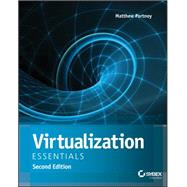Virtualization Essentials, Second Edition provides new and aspiring IT professionals with immersive training in working with virtualization environments. Clear, straightforward discussion simplifies complex concepts, and the hands-on tutorial approach helps you quickly get up to speed on the fundamentals. You'll begin by learning what virtualization is and how it works within the computing environment, then you'll dive right into building your own virtual machine. You'll learn how to set up the CPU, memory, storage, networking, and more as you master the skills that put you in-demand on the job market. Each chapter focuses on a specific goal, and concludes with review questions that test your understanding as well as suggested exercises that help you reinforce what you've learned.
As more and more companies are leveraging virtualization, it's imperative that IT professionals have the skills and knowledge to interface with virtualization-centric infrastructures. This book takes a learning-by-doing approach to give you hands-on training and a core understanding of virtualization.
- Understand how virtualization works
- Create a virtual machine by scratch and migration
- Configure and manage basic components and supporting devices
- Develop the necessary skill set to work in today's virtual world
Virtualization was initially used to build test labs, but its use has expanded to become best practice for a tremendous variety of IT solutions including high availability, business continuity, dynamic IT, and more. Cloud computing and DevOps rely on virtualization technologies, and the exponential spread of these and similar applications make virtualization proficiency a major value-add for any IT professional. Virtualization Essentials, Second Edition provides accessible, user-friendly, informative virtualization training for the forward-looking pro.








